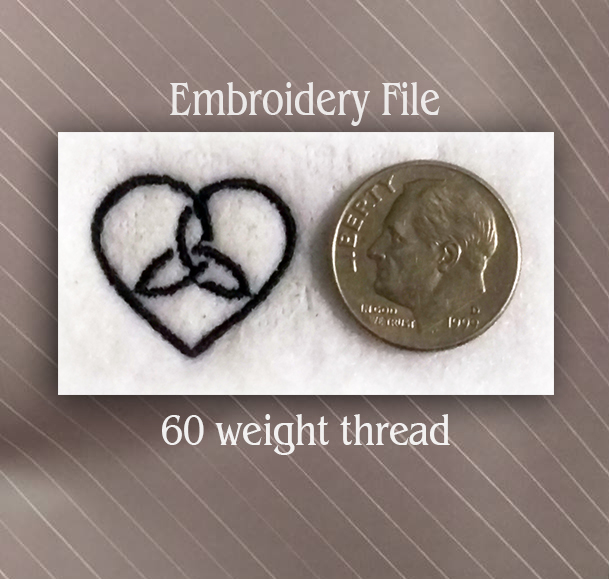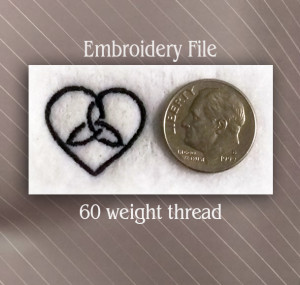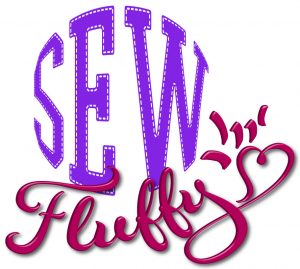
The Tangled Embroidery Thread We Weave:
Embroidery is simply the act of layering threads to produce art. While the selection of thread as a whole is varied, the choice of embroidery thread generally falls into two distinct types: Rayon and Polyester. While it is technically feasible to use cotton, nylon or even silk, embroidery threads in rayon a in polyester are distinctly made to perform two functions: to lay flat on fill areas, and to wear evenly as a top surface without the need to be woven into a cloth mesh.
What your digitizer expects:
40 weight polyester thread: most digitizers use this density weight on their designs and have a specific density set for that weight, if you use another weight thread it might be too thin or too thick for that file and will look sparse with gaps or thick with too much thread.
Rayon or Polyester Embroidery Thread?
What is the difference? A lot if you look closely. Rayon is the most popular and affordable machine embroidery thread. It is easy to find at craft stores, simple to use and available in a myriad of vibrant colors. Made of organic cellulose, often from wood pulp, rayon fibers have a luxurious sheen and soft touch. Despite the beauty, it can fade over time and is a poor choice for light colored garments. The dye in rayon threads are also known to bleed into white shirts, rayon is not colorfast and this should be a concern when a garment expects heavy use, consistent washing and especially if it may be white and require bleaching. Because rayon is organic, it often frays often while being embroidered, especially with worn or incorrectly sized needles, and can end up with a fuzzy look that may not be intended. Years ago I used to work for a small but successful shop; we had a large repeat order from an area hospital that we nearly lost due to the owner pinching pennies and switching our threads over to rayon as a management decision. We had to do thousands of lab jackets over again when they were returned after their first washing, and buzzing out is always more costly and time consuming then spending the extra on better thread. Hospitals bleach everything, and the thread being rayon bleached all the logos white… needless to say it was a lesson learned, and my own machines are solely loaded with polyester for all my customers to avoid that very issue.
What’s so special about polyester embroidery thread?
Polyester is totally synthetic, and as such the color is not dyed onto the fabric of the thread, rather it is part of the structure of the thread, its chemical makeup. Polyester is inherently stronger: it’s made of a myriad of tightly wound mono-filament strands producing a rope like chord in micro, creating a thread that tends to break rather than fray. The thread is also shiny, so it creates a nice soft shine to the embroidery, and creates what I believe is a deeper richness in its colors. Some will say but polyester is more money, I say the difference in operation and outcome outweighs the minor expense of getting polyester over rayon. Sometimes when cleaning up a sew out, we get an area that needs to be cut and weeded out, removing jumps or even areas that have frays or broken thread end after a thread break. Sometimes, no matter how good my scissors are, thread frays and I can’t get it out. Polyester allows you to take a flame lighter, not a torch, and very lightly touch up that area. Being a synthetic plastic, Polyester will coil back and shrink away so you no longer can see any frays. You can’t do that with rayon as the thread will burn, and you will end up with black marks on the thread. Now in doing this, be very careful not to leave the lighter on too long or too close you can burn the fabric or melt the surrounding stitches.
Different weight embroidery thread for different purposes…

Most digitizing is centered on 40 weight thread, as it is common and fills large areas without putting excessive whole through the substrate fabric. There are other weights and on occasion it is helpful to consider sewing out in those weights, especially if the design and digitizing artist have called for it. I actually love 60 weight threads; it is very thin and works great for small lettering. However we have to be aware that density changes based on thread weight as well as the type of material we are embroidering onto. As thread gets thinner, more density is necessary to cover the same area. 60 weight threads are smaller and require a thinner needle. When logos have tiny letters and fine details, it often helps to switch to 60 weight thread; if you find a design where the minute details are being eaten by the wide thread, than try 60 weight and 65/9 needle you would be shocked to see what a difference it can make! I’ve included a file to download for free that is specifically for 60 weight thread it is a tiny .75 inch Celtic heart as you can see from the image it is the size of a dime; click on image to go to the free file. If you would like more sizes that are not for 60 weight it will be on sale for a short time check it out here.
Metallic Embroidery Thread:
Most metallic threads are thicker, usually 20 to 30 weight, and it is why many have problems sewing these out. I’ve had to learn tricks over the years, and many are machine specific, its best to experiment and see what works best on your machine. When working in metallic, try and lower the density if your machine allows, and use at least an 80/12 or 90/14 needle. These are larger needles and will work better because the thread is usually a metal mono-filament wrapped with clear polyester filaments, and the larger needle’s eyelet will let the kink riddled metallic pass more smoothly through it. The Metallic likes to kink as all of its components have different pliability; metallic mono-filament is less pliable than the polyester that encompasses it. Metallic thread will kink up, fray, and break easily while being sewn: slow the machine down. If your machine allows for upper thread tension to be changed, play around with the tension: thicker thread requires less tension; loosen it slowly and watch it sew to see where it looks best.

The Coupon Code for the 60 Weight Celtic heart file above is: 60Weight